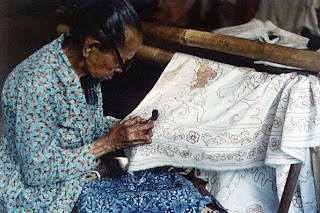What is batik?
I can safely make this statement that while many people know or have heard about this word, especially so here in Malaysia, Singapore and Indonesia, but many people do not, or rather, have got a wrong misconception of batik itself.
In my discussions with friends and general public, many people have mistaken batik with batik design/ batik designs or even batik fabric.
History has it that batik is an old craft that dates centuries back. Batik is actually a hand-drawn and hand-painted technique, which uses wax.
The wax is a form of 'resist' method, and the purpose of this method is so that when colour is put on a certain spot on the fabric, it does not run to the other part. Let's take an example - an artist is is going to draw a floral motif and he wants the background blue eg. the motif of a flower (a yellow flower with a green stalk).
Now, imagine that the artist will be drawing on a white piece of cloth. The artist will first draw the outline of the motif (ie. the flower & stalk) with wax. And later, he will start to paint, starting with the yellow colour of the flower. What the wax does is to hold the yellow in place, so that it will not run to the green stalk. And when he paints with green next, the same thing applies, that is the green will not flow to the yellow flower. Finally, he paints the blue background.
And of course, the artist will later have to wash the wax off the cloth, hence leaving that part which was originally covered with wax back to its original white fabric colour. Hence, the white outline for the motif. And that is all it is to the meaning of batik.
However as mentioned earlier, a lot of people mistake batik with batik design/ batik designs especially if they see a traditional or floral type motif, or patterns on a cloth that have white outlines. These may or may not necessary come from the 'batik' technique, as it could come from modern day print.
In addition, just because these prints have the more traditional motifs/ patterns, don't mistake them to come from the art form of batik.
In fact, there are modern designs, which actually are made from the batik technique as well. But people do not know it is so because it does not have the traditional look and feel to it.
So my suggestion to you that if you appreciate art, and batik in particular, first be aware whether the fabric you buy really comes from the batik art. And secondly to be open minded to embrace the change in modern times that batik need not necessary relate just to old motif/ patterns.

